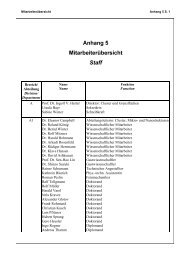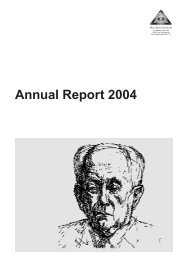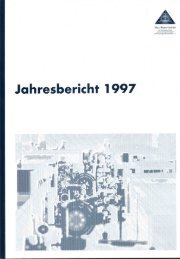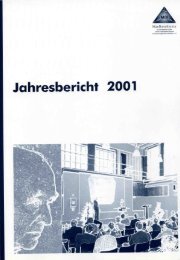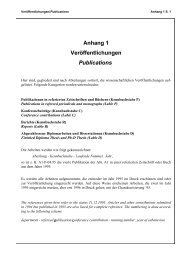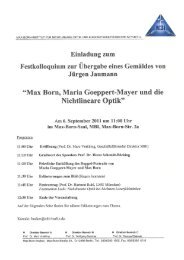You also want an ePaper? Increase the reach of your titles
YUMPU automatically turns print PDFs into web optimized ePapers that Google loves.
i(pq - qp) = (h/2π),<br />
statistical<br />
of<br />
48<br />
<strong>Max</strong> <strong>Born</strong> • Paul Corkum<br />
In 1921, <strong>Max</strong> <strong>Born</strong> was appointed to a chair in Göttingen as the successor to Peter Debye.<br />
Together with James Franck, whose appointment to a post at Göttingen he made a precondition<br />
for accepting his own chair, and Robert Wichard Pohl, <strong>Born</strong> then became the founder of<br />
the famous Göttingen School. At this time <strong>Born</strong> began to concern himself with the quantum<br />
physics of atoms. Basic inadequacies had become apparent in Bohr’s treatment of the atom<br />
model. The conformity of quantum physics at the time with classical physics, maintained via<br />
the correspondence principle, had led to quantum rules that could be used to describe the simple<br />
hydrogen atom, but which already failed in their treatment of problems of even slightly<br />
greater complexity, such as the scattering of light and the influence of static magnetic and electric<br />
fields.<br />
The interest of <strong>Max</strong> <strong>Born</strong> and his colleagues in atomic physics was attracted by the lectures<br />
given by Niels Bohr in Göttingen in 1922. Initially, they sought a solution in Göttingen within<br />
the framework of many-body models oriented to classical physics. <strong>Born</strong>’s assistant, Werner Heisenberg,<br />
then succeeded in finding the solution during his famous trip to Heligoland in 1925.<br />
Heisenberg treated the spectral lines of the atom on the basis of a system of oscillators by<br />
replacing the classical amplitudes of the emitted radiation by quantum-theory amplitudes,<br />
which depend on two figures characterizing the transition from one state to another. He succeeded<br />
in transcribing Bohr’s quantum condition within the framework of the same assumptions<br />
and discovered that his formulation perfectly fulfilled the principle of the conservation of<br />
energy, which had been a problem for earlier treatments of semi-classical concepts.<br />
Fulfilling Ritz’s combination principle required the rule of noncommutative multiplication. After<br />
Heisenberg’s return from Heligoland, <strong>Born</strong> recognized that the result intuitively discovered by<br />
Heisenberg was the formation of a product of matrices. Today we know <strong>Max</strong> <strong>Born</strong>’s formulation,<br />
i(pq - qp) = (h/2π), which is also inscribed on his gravestone in Göttingen, in the form of<br />
Heisenberg’s commutation relations between the components of the operator of the space<br />
coordinate and the component of momentum. <strong>Born</strong> thus became the father of the matrix formulation<br />
of quantum theory.<br />
In the following years, <strong>Born</strong> devoted himself to the application of quantum mechanics to<br />
nonperiodic and time-dependent processes, especially of scattering theory. In 1933 he wrote<br />
his famous book on optics, which, when forced into exile in Edinburgh by the Nazis, he<br />
later revised with Emil Wolf and republished in 1959 as “The Principles of Optics”. This book,<br />
which we still use as a reference in my institute even today, has since become a standard<br />
work of modern optics.



